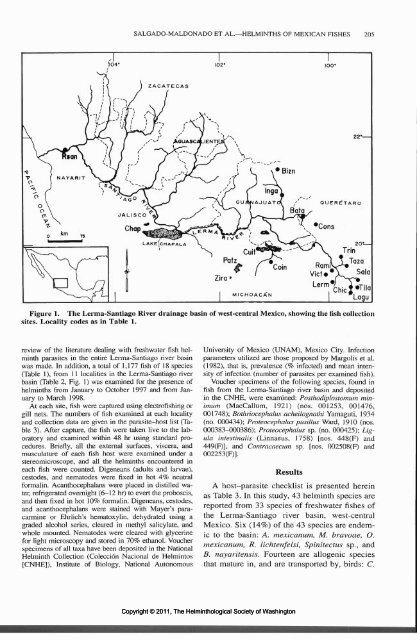Comparative Parasitology 68(2) 2001 - Peru State College
Comparative Parasitology 68(2) 2001 - Peru State College
Comparative Parasitology 68(2) 2001 - Peru State College
Create successful ePaper yourself
Turn your PDF publications into a flip-book with our unique Google optimized e-Paper software.
JALISCO<br />
SALGADO-MALDONADO ET AL.—HELMINTHS OF MEXICAN FISHES 205<br />
Chap '<br />
LAKE'CHAPALA<br />
Figure 1. The Lerma-Santiago River drainage basin of west-central Mexico, showing the fish collection<br />
sites. Locality codes as in Table 1.<br />
review of the literature dealing with freshwater fish helminth<br />
parasites in the entire Lerma-Santiago river basin<br />
was made. In addition, a total of 1,177 fish of 18 species<br />
(Table 1), from 11 localities in the Lerma-Santiago river<br />
basin (Table 2, Fig. 1) was examined for the presence of<br />
helminths from January to October 1997 and from January<br />
to March 1998.<br />
At each site, fish were captured using electrofishing or<br />
gill nets. The numbers of fish examined at each locality<br />
and collection data are given in the parasite-host list (Table<br />
3). After capture, the fish were taken live to the laboratory<br />
and examined within 48 hr using standard procedures.<br />
Briefly, all the external surfaces, viscera, and<br />
musculature of each fish host were examined under a<br />
stereomicroscope, and all the helminths encountered in<br />
each fish were counted. Digeneans (adults and larvae),<br />
cestodes, and nematodes were fixed in hot 4% neutral<br />
formalin. Acanthocephalans were placed in distilled water,<br />
refrigerated overnight (6—12 hr) to evert the proboscis,<br />
and then fixed in hot 10% formalin. Digeneans, cestodes,<br />
and acanthocephalans were stained with Mayer's paracarmine<br />
or Ehrlich's hematoxylin, dehydrated using a<br />
graded alcohol series, cleared in methyl salicylate, and<br />
whole mounted. Nematodes were cleared with glycerine<br />
for light microscopy and stored in 70% ethanol. Voucher<br />
specimens of all taxa have been deposited in the National<br />
Helminth Collection (Coleccion Nacional de Helmintos<br />
[CNHE]), Institute of Biology, National Autonomous<br />
University of Mexico (UNAM), Mexico City. Infection<br />
parameters utilized are those proposed by Margolis et al.<br />
(1982), that is, prevalence (% infected) and mean intensity<br />
of infection (number of parasites per examined fish).<br />
Voucher specimens of the following species, found in<br />
fish from the Lerma-Santiago river basin and deposited<br />
in the CNHE, were examined: Posthodiplostomum minimum<br />
(MacCallum, 1921) (nos. 001253, 001476,<br />
001748); Bothriocephalus acheilognathi Yamaguti, 1934<br />
(no. 000434); Proteocephalus pusillus Ward, 1910 (nos.<br />
000383-000386); Proteocephalus sp. (no. 000425); Ligula<br />
intestinalis (Linnaeus, 1758) [nos. 448(F) and<br />
449(F)], and Contracaeciim sp. [nos. 002508(F) and<br />
002253(F)].<br />
Results<br />
A host-parasite checklist is presented herein<br />
as Table 3. In this study, 43 helminth species are<br />
reported from 33 species of freshwater fishes of<br />
the Lerma-Santiago river basin, west-central<br />
Mexico. Six (14%) of the 43 species are endemic<br />
to the basin: A. mexicanum, M. bravoae, O.<br />
mexicanum, R. lichtenfelsi, Spinitectus sp., and<br />
B. nayaritensis. Fourteen are allogenic species<br />
that mature in, and are transported by, birds: C.<br />
Copyright © 2011, The Helminthological Society of Washington
















